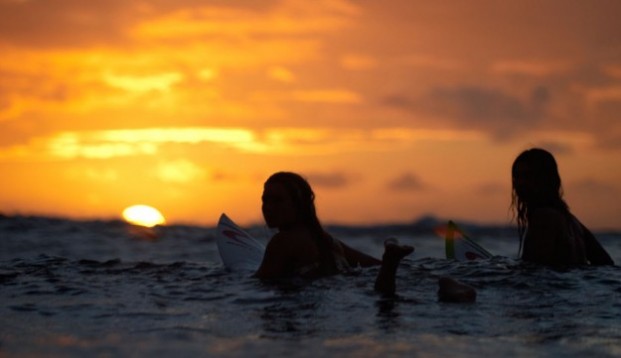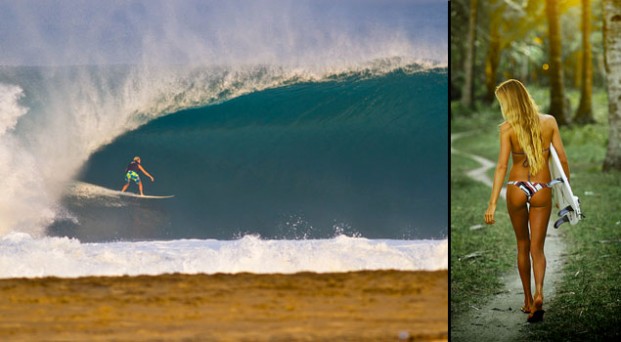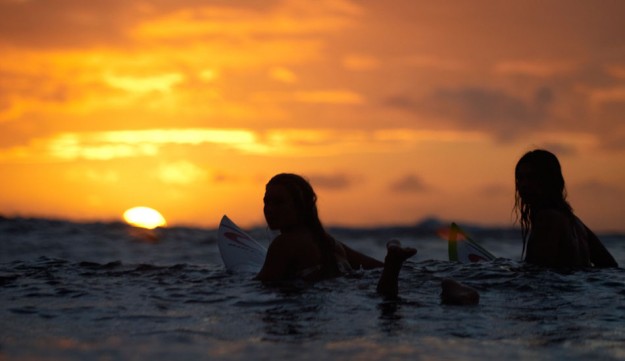Written by Clare Sullivan (Student/Writer/Surfer)
Originally published by The Inertia

Earlier this year, around the time of the inaugural Australian Open of Surfing in Manly, I found myself at a friend-of-a-friend’s barbecue. Of the twelve or so guests, my girlfriend and I were the only ones who weren’t female professional surfers. I didn’t need to be told. Many of them had made appearances in my life before, carving across the pages of one of the surfing mags piled up next to my bed or grinning at me from a window display as I bought Havaianas.
On the balcony of an ultra-modern holiday rental property overlooking one of Australia’s iconic beaches, we sat around a table spread with organic meat, quinoa salads and wine – for those who weren’t competing the next day – chatting and swapping stories. At some point it emerged that everyone in the group was either sitting next to their girlfriend, an ex, or a future love interest. Despite resenting the ways in which queer women are stereotyped, I was ashamedly surprised by this little matrix of same-sex attraction: you would be hard-pressed to find such long, blonde hair and deep tans in a straight club on a Saturday night, let alone a gay one. Nevertheless, being surfers ourselves, my girlfriend and I were enamored with these women and their lifestyle.
Then, the wine dried up, the sun went down, and it was over. We spent the whole drive home talking about these women; their travel plans, their quivers, their free clothes and surf gear, their tans, and their good looks. It seemed like they had it all.
Having gotten to know these girls better over the last few months, the illusion of ‘it all’ has been washed away. Instead, I find myself coming to the conclusion that being a female professional surfer isn’t always what it’s cracked up to be, especially if you’re not straight.
***
Women’s surfing is in trouble. While society is slowly moving forward in regards to women’s and queer rights, the surfing industry is stuck in a time warp, somewhere between Puberty Blues and the Bra Boys. Reliant upon and driven by its sponsors, professional surfing has become entwined with the marketability of surf culture, and the results are disastrous, particularly for women. To the detriment of some of the world’s most talented athletes, femininity and heterosexuality remain pre-determinants of sponsorship and media attention, and often, one’s ability to succeed in the sport.
With sponsorship drying up, no one is chomping at the bit to ‘out’ themselves or bad-mouth the industry, so respect the fact that the surfers I have spoken to have chosen to remain anonymous. Just know that between them they have 12 years experience of being in the ASP Women’s Top 17.
The Reality of Being a Female Pro Surfer
You may have heard it all before, but just to re-hash, the costs of competing as a professional surfer are huge, regardless of gender. One surfer I spoke to lost her main sponsor in 2011, and had to choose between funding her time on the 2012 ASP Women’s World Tour out of her own pocket, or giving up her dream of winning a world title. She picked surfing, and estimates that it cost her about $50,000 for the year. The occasional novelty check is only the icing on the cake and by no means enough to cover costs. To fund a career in professional surfing, let alone make a living, surfers are forced to turn to sponsorship; a reliance that has both blessed and plagued all surfers with dreams of going big.
While the ASP governs the industry and sanctions all the events, sponsors play a key role in funding these events and financing prospective competitors – a task mainly taken on by the “Big Three”: Rip Curl, Billabong and Quiksilver. This is where gender kicks in. Being businesses, the sponsors are motivated by high returns, and when it comes to profitability, women’s surfing struggles. Women’s events only draw a fraction of the crowds that the men’s events do, so they receive a fraction of the funding, and in the wake of the GFC, the gap between the number of events scheduled for men compared to women is only widening.
When it comes to the female surfers themselves, their viability to a brand is often tied up with how they look. As far as target markets go, there are relatively few women who surf in the world, so while the boys are celebrated for their skill and strength as surfers, the girls’ appeal is stretched to fit a more broad, mainstream audience. As one of the surfers (hereafter referred to as BBB) told me, “It’s all about marketing. If you appeal to a greater market they are going to hold onto you.”
BBB explains how the women are coaxed down one of two paths. They are either pawned off to the already established audience of male surfers, by keeping the sporting element but adding anAlana Blanchard variety of sex-appeal to make up for a perceived deficit in skill, or, turned into a lifestyle symbol for young, non-surfing females. Either way, their surfing takes a back seat. “They came to me and said ‘we don’t know how to market you’” says BBB, who was “forced to femme up” when she entered the industry at 19, and ditch the board-shorts for a bikini. She doesn’t seem too stoked about this but is resigned to the fact that it helped pay the bills, and tells me that it was something she never took personally. “They own your arse… the person is taken out of the equation when you become a product; you lose your privacy and become other people’s property and that’s it, you accept that.” As Tetsuhiko Endo highlights, when you contact company reps for comment on the matter they will either decline or refuse to answer: “Very few people in the industry want to go on record to even discuss the notion of a double standard. The surf world is too small and too conservative.”

But it’s not just the sponsors who are to blame. Largely complicit, the surf media feeds off the advertising material produced by the sponsors, and in their attempt to give readers what they want, publish content which falls squarely within the dominant “tits and ass” approach to female surf culture. For a consistent source of proof that sex appeal is emphasized over athleticism in women’s surfing, you needn’t look past surfing mags, where the majority of the women featured are femmed-up for on-land photo-shoots rather than actually surfing and demonstrating their ability.
Collectively, the different components of the surf industry – the sponsors, the media and the toothless ASP – have produced an environment where female surfers are valued for their looks over their ability. Looking at the generically attractive top 17, you can’t help but wonder whether femininity and beauty have become the ultimate levelers in women’s surfing.
Heterosexuality and the Carbon-Copy Girl
So where does heterosexuality come in? Having surfed professionally since her teens, BBB’s ex-girlfriend (hereafter referred to as ‘AAA‘) explains how within “image oriented” surf culture, “surfer girl,” “hot” and “straight” are assumed to flow from each other flawlessly. “The top 17 of us are completely different, but I feel like they try and put us in one category. In a perfect world, they want us to all wear g-strings, be straight and pretty.” Any breaks in the chain are unwelcome and usually rendered invisible, with heterosexuality relied upon just as much as femininity to make the surfers accessible, admired and desired by the wider world.
Cori Schumacher, 3-time world longboard champion and out lesbian, understands this all too well. She explains how the “oligarchy” of the surf industry – the ASP, sponsors and the media – go to significant lengths to maintain the vision of the heterosexual, carbon-copy girl as part of its attempts to “move from a marginalized sport to a more mainstream, higher profit-making institution.”
BBB agrees in the most part. In an industry that is “very straight and always tries to touch on the cool … there’s still a massive stigma associated with gayness,” however, she concedes that adherence to the norm is not always synonymous with commercial success, and cites the examples of Keala Kennelly andClaire Bevilacqua . These queer – and undeniably less femme – women aligned themselves with brands like Volcom and Red Bull which one might argue symbolize a counter-culture of energy and rebellion rather than bikinis and softness. And it worked. “KK has got more of a following and has been really successful…They had an angle which worked with both guys and chicks. The guys respect her and she has a market with girls as well so they ran with that.” But these women are an exception to the rule. It’s undeniably a trickier path to tread, which closes a number of doors while opening the women up to scrutiny within and outside of the industry.
Even within the competitors’ circle, it’s not easy to be seen as queer. BBB has been labelled from within the surf industry as “gay” since they cottoned on to the fact that she had a long-term girlfriend. She tells me about some run-ins she had with other competitors before her heats, who would make comments about her sexuality to try and throw her off her game, and describes a staunch divide between the queer surfers and the straight ones, who are terrified of being ‘tainted’ with allegations of queerness. AAA explains that murmurs of new same-sex relationships or left of the spectrum sexual behavior become the school-yard gossip on tour. At this point, the benefits of coming out are fading before my very eyes, even before I open the floor up to the girls themselves to explain why they can’t or don’t want to.
One woman (hereafter referred to as ‘CCC‘) dated a high-profile surfer during 2008 and 2009 until their relationship folded under the pressure her ex-girlfriend felt was on her to present as straight. “I definitely think [name omitted] loved me and cared about me, but the decisions she made to try and make others happy – family, country, the industry – outweighed that.” She tells me that the few times she went along to comps her ex-girlfriend wouldn’t want them to be seen together at all. “Which I think made it more obvious because she was acting so oddly.” CCC explains that her ex-girlfriend was “uncomfortable with anyone knowing the she was with a girl so she would go to extremes to try and stop those rumors or disprove them by sleeping around with men.”
For AAA, her decision not to come out really comes down to sponsorship. “I was still trying to be straight and girly just because I thought that’s what would keep the sponsors – that it would keep me getting paid.” She tells me that while they never actually said anything directly to her about sexuality, through things like the outfits they picked out for her to wear to industry events, the importance of femininity – and requisite heterosexuality – was implied. She explains that while sponsors are ultimately more phased by how much money they can make out of you, and “how good your arse is” than who you sleep with behind the scenes, there is an unspoken belief on both sides that an illusion of heterosexuality holds the most gains.
BBB explains that she never tried to hide her sexuality, but that her refusal to come out is more of a personal choice. Interestingly, her sponsors came to her early on in her career and asked her outright if she was dating a woman, and told her that it didn’t mind as long as she was relaxed and happy. “I was like, ‘if you want me to be that way then why are you asking?’ The industry knew before any of my close friends and family. It’s intrusive.” Even with the support of her sponsors she wouldn’t embrace that label. “For me, it’s not an identifier – it is what it is. It pisses me off that someone will say ‘oh, is she the gay one?’…I’ve got a sister with a disability and it’s the first thing anyone ever perceives of her, and she’s so much more than that, and it’s like, everyone is different and everyone should get the fuck over it.”
Last week, my girlfriend and I were at a trendy restaurant in Bondi, surrounded by a group of female professional surfers. We swapped stories and chatted about our plans for the following year. Then, the wine dried up, the sun went down, and it was over. My girlfriend and I spent the whole drive home talking about these women; their struggles to keep sponsors, the way they are scrutinized by the industry, the consequences of being treated like a reluctant bikini model rather than an athlete, and how difficult it would be to sustain a relationship with someone under wraps. It seems like if this is what it’s like to be a queer, female professional surfer, then women’s surfing is in trouble.



Such an awesome article Clare! Great to see a discussion about this topic as I feel like it is so rarely talked about!